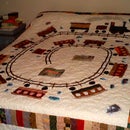Introduction: Structured Wiring System Design
This instructable shows the structured wiring system that I designed for my home.
This wiring system provides a centralized location for the following services for all of my rooms (master, 3 bdrm, kitchen, living, garage, office).
1) Local area network (LAN),
2) File server and backup,
3) Telephone,
4) Cable HDTV,
5) Power surge,
6) Power conditioning,
7) Signal Amplification,
8) Internet,
9) Battery backup.
I don't have actual construction photos since I didn't take any but i'll show and describe the final solution that I came up with.
This wiring system provides a centralized location for the following services for all of my rooms (master, 3 bdrm, kitchen, living, garage, office).
1) Local area network (LAN),
2) File server and backup,
3) Telephone,
4) Cable HDTV,
5) Power surge,
6) Power conditioning,
7) Signal Amplification,
8) Internet,
9) Battery backup.
I don't have actual construction photos since I didn't take any but i'll show and describe the final solution that I came up with.
Step 1: Schematic and Materials List
The schematic for the whole house structured wiring system is shown in this image. I have also attached PDF file which may be a bit clearer.
Parts Listing:
1) Cat-5e (internet, lan)
2) COAX RG-59 or RG-6 (cable tv, antenna)
3) Phone cable (telephone, cable telephone)
4) Romex Electrical wire (electricity)
5) 4-port Wired/Wireless-N Router
6) 16-port Switch
7) Electrical outlets
8) 8-way video splitters
9) 2-way video splitter
10) Cat5 patch panel
11) telephone patch panel (bus bar)
12) cable modem
13) file server - primary
14) file server - backup
15) surge protecter, battery backup (cable, phone, electrical, lan)
16) cable try (metal studs)
17) outlets (ethernet, phone, cable)
18) cable ties.
Parts Listing:
1) Cat-5e (internet, lan)
2) COAX RG-59 or RG-6 (cable tv, antenna)
3) Phone cable (telephone, cable telephone)
4) Romex Electrical wire (electricity)
5) 4-port Wired/Wireless-N Router
6) 16-port Switch
7) Electrical outlets
8) 8-way video splitters
9) 2-way video splitter
10) Cat5 patch panel
11) telephone patch panel (bus bar)
12) cable modem
13) file server - primary
14) file server - backup
15) surge protecter, battery backup (cable, phone, electrical, lan)
16) cable try (metal studs)
17) outlets (ethernet, phone, cable)
18) cable ties.
Attachments
Step 2: Tools Used
Tools:
1) Wire cutters,
2) Wire stripper for coax, phone, cat-5.
3) Wire spool holder,
4) Pop rivet tool,
5) Screw driver,
6) Wrench set,
7) cable ties
Building shelving not covered here but used the following tools:
1) Table saw,
2) Sander,
3) Scroll saw,
4) Electric drill,
5) Screw Drivers
1) Wire cutters,
2) Wire stripper for coax, phone, cat-5.
3) Wire spool holder,
4) Pop rivet tool,
5) Screw driver,
6) Wrench set,
7) cable ties
Building shelving not covered here but used the following tools:
1) Table saw,
2) Sander,
3) Scroll saw,
4) Electric drill,
5) Screw Drivers
Step 3: Assembly Details
This picture shows the overall assembly and its parts.
Cut sheet rock window in the wall of a closet, dont' cut all the way through the wall, just back to the sheet rock on the other side of the wall,
The shelf is build in three sections that slides between the exposed wall studs. Build the shelves back into the wall opening that you created.
I used wood wall paneling (masonite) and MDF (1/2" to 3/4") to create these shelves. PVC tubing to route wires into attic.
Cut sheet rock window in the wall of a closet, dont' cut all the way through the wall, just back to the sheet rock on the other side of the wall,
The shelf is build in three sections that slides between the exposed wall studs. Build the shelves back into the wall opening that you created.
I used wood wall paneling (masonite) and MDF (1/2" to 3/4") to create these shelves. PVC tubing to route wires into attic.
Step 4: Installation Details
Here are details of the installation.







